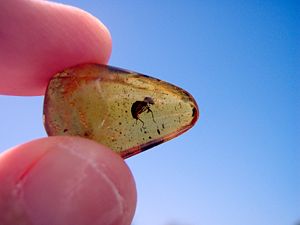November 20, 2013 – Researchers at the University of Innsbruck reconstructed Earth’s atmosphere during the Age of the Dinosaurs and were surprised by the results. It turns out that the amount of oxygen in the atmosphere back then was far less than today contradicting what was generally believed to be the opposite. Theories of why insects were so big in Earth’s biological past and why dinosaurs grew to such immense size often suggested higher oxygen levels.
But in studying 538 amber samples dating from the Triassic, 220 million years ago, the mid-Cretaceous, 100 million years ago, and the early Eocene, 56 million years ago, and comparing them to modern resins emitted by trees, the researchers determined that oxygen levels varied between 10 and 15% in these earlier periods in the geological history of the planet and were not as high as previously thought during the Age of the Dinosaurs. This contradicts previous studies on the subject. You can read the original paper in the Geochimica et Cosmochimica Acta journal. The team of authors are all scholars in a variety of fields including mineralogy, paleontology and geochemistry.
Oxygen levels have always varied throughout Earth’s history. Before photosynthesis there was no free oxygen in the atmosphere. Earth’s earliest atmosphere received its earliest doses of oxygen most likely from single cell organisms and oxidation of surface rocks. As plant life evolved oxygen levels rose.
Scientists in the past suspected that at maximum oxygen levels reached 35% some 250 million years ago, a time known as the Permian extinction. That extinction wiped out much of animal and plant life on the planet with oxygen levels dropping to 15% or less. This seems to be consistent with this latest study using fossil amber as the data source.
Why amber? Fossilized resins which is what amber is, comes from cone bearing trees that lived millions of years ago. These sticky secretions would ooze from trees and trap and preserve not just plant material but animal life as well. Also trapped in amber were small bubbles of air from the atmosphere that existed at the time. So in studying amber the scientists believe they have a pretty accurate measure of Earth’s more ancient atmosphere.










